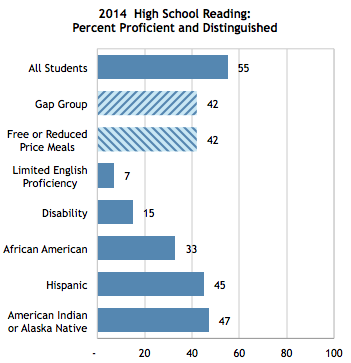
Which student subgroups have the worst achievement gaps, so severe that the group performs like the lowest 1% of all students? In Kentucky, gaps that deep earn a "focus school" identification under Kentucky's accountability regulation. (Technically, the designation applies when a subgroup has "a score in the third standard deviation below the state average for all students," but that works out to something very like the bottom 1%.)
In this year's list of focus schools, students with disabilities are, by far, the group most likely to have results that earned that designation. The pie chart above shows that for reading, and matching charts below show that that the pattern is similar for every other subject Kentucky tests.
I don't like what I see in these charts, but I do like being able to see it. We should not hide from this kind of truth about how we are doing as a state. In each community where a student group is struggling this deeply, we should be talking about the problem and pulling together to solve it.
We should be pulling together to meet children's needs if the group being left so far behind is students with disabilities. We should engage just as intensely if the group is African-American students, Hispanic students, students with limited English proficiency, or students who qualify for free or reduced-price meals: those problems happen in fewer schools, but when they occur they are just as urgent.
Do the schools in your community have a student subgroup that is being left this far behind? You can find the full list of Focus Schools by going to the Supplemental Data portion of KDE's Open House Portal, clicking the link for Accountability, and scrolling to the bottom of the page. Please do check, and please do discuss what you find with your neighbors and your local school leaders. We can change this picture, but only if we see it and engage it.
























